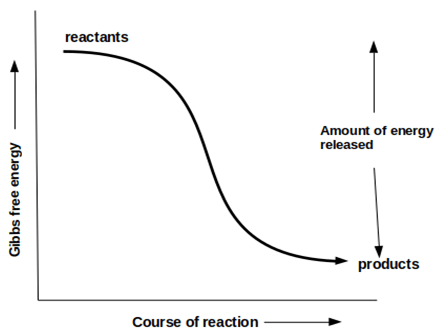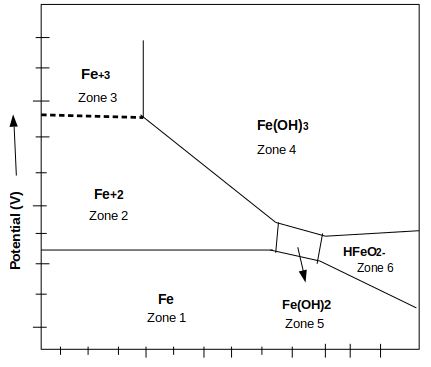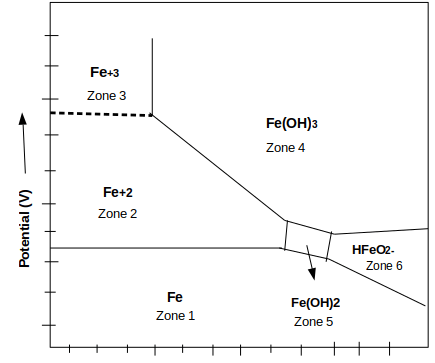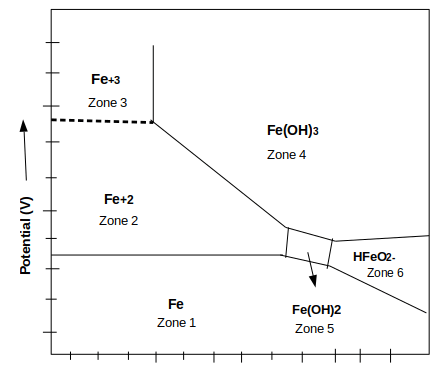This set of Corrosion Engineering Objective Questions & Answers focuses on “Modern Theory Principles – Thermodynamics – 2”.
1. Which of the following is a cathode and anode respectively in the Ag-Fe system?
a) Iron (Fe) and Silver (Ag)
b) Silver (Ag) and Iron (Fe)
c) Gold (Ag) and Iron (Fe)
d) Iron (Fe) and Gold (Ag)
View Answer
Explanation: In the Ag-Fe system, Silver (Ag) (+0.80V) acts as a cathode as the standard hydrogen potential is relatively higher than the Iron (Fe) (-0.44V) and Iron acts as anode due to relatively less standard hydrogen potential.
2. An electrochemical reaction is always a combination of oxidation half-cell and a reduction of half-cell.
a) True
b) False
View Answer
Explanation: Corrosion is usually an electrochemical process which is a combination of oxidation half-cell and reduction half-cell. Oxidation and reduction reactions are simultaneous in nature and it is also called Redox reactions.
3. What is the cathodic and anodic reactions respectively of Cu-Ag system?
a) Ag==>Ag+2+2e and Cu+2+2e==>Cu
b) Cu==>Cu+2+2e and Ag==>Ag+2+2e
c) 2Ag+1+2e==>2Ag and Cu==>Cu+2+2e
d) 2Ag==>2Ag+1+2e and Cu+2+2e==>Cu
View Answer
Explanation: Standard hydrogen potential of silver (Ag) is +0.80V and copper is +0.34V.
Cathodic reaction: 2Ag+1+2e==>2Ag
Anodic reaction: Cu==>Cu+2+2e
4. Which of the following type of reaction is shown in the given figure?

a) Non-spontaneous reaction
b) Equilibrium reaction
c) Neither spontaneous nor non-spontaneous reaction
d) Spontaneous reaction
View Answer
Explanation: Spontaneous reaction is a reaction in which the change in Gibbs free energy is negative. It means the free energy of reactants is more than the free energy of products.
5. Which of the following diagrams shows the stability of metals over a range of pH and potential of a system?
a) Phase diagrams
b) Pourbaix diagrams
c) Phase diagrams and Pourbaix diagrams
d) Colling curves
View Answer
Explanation: Pourbaix diagrams show the stability of metal over a range of pH and potential of a system. It also includes native zone, passive zone, and corrosive zone. It is also called as potential-pH diagrams.
6. What is depicted in the given figure?

a) Phase diagram of the Fe-C system
b) Pourbaix diagram for Fe-O2 system
c) Pourbaix diagram for Fe-H2O system
d) Colling curve pure iron
View Answer
Explanation: Pourbaix diagram is a diagram that shows the stability of species of a metal over a range of pH and potential of a system. Given figures represents the pourbaix diagram of the Fe-H2O system.
7. Which of the following zone of given Pourbaix diagram indicates the immune zone?

a) Zone 1
b) Zone 2
c) Zone 3
d) Zone 4
View Answer
Explanation: The Immune zone is the zone of the pourbaix diagram in which the stability of native metal in zero oxidation state is high. It is the zone in which no corrosion or passivation takes place.
8. Which of the following zone(s) of given Pourbaix diagrams indicate a passive zone?

a) Zone 1 and 2
b) Zone 2 and 3
c) Zone 2, 3 and 6
d) Zone 4 and 5
View Answer
Explanation: Passive zone is the zone in the pourbaix diagram in which the passivation of metal takes place. It is the operating zone in various industries to minimize corrosion and to increase the efficiency of the process.
9. Which of the following is/are the applications of Pourbaix diagrams?
a) Predicting the spontaneous direction of reactions
b) To reduce corrosion attack
c) To reduce corrosion attack, to predict the direction of spontaneous reaction and to estimate the composition of corrosion product
d) To estimate the composition of corrosion product
View Answer
Explanation: Applications of Pourbaix diagrams:
i. Predicting the spontaneous direction of reactions
ii. To reduce corrosion attack
iii. To estimate the composition of corrosion product.
10. Which of the following is/are the limitations of Pourbaix diagrams?
a) Rate of reaction is can’t be predicted
b) It neglects the impurities of working conditions
c) Stability of metallic species is predicted
d) Rate of reaction is not predicted and it neglects the impurities of working conditions
View Answer
Explanation: Limitations of Pourbaix diagrams:
i. Rate of reaction can’t be predicted
ii. It neglects the impurities of working conditions
iii. Alloying elements of alloys are also neglected.
Sanfoundry Global Education & Learning Series – Corrosion Engineering.
To practice all objective questions on Corrosion Engineering, here is complete set of 1000+ Multiple Choice Questions and Answers.
If you find a mistake in question / option / answer, kindly take a screenshot and email to [email protected]
- Check Mechanical Engineering Books
- Practice Metallurgical Engineering MCQs
- Apply for Mechanical Engineering Internship
- Practice Mechanical Engineering MCQs
- Check Metallurgical Engineering Books
